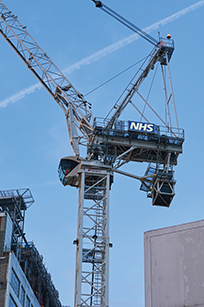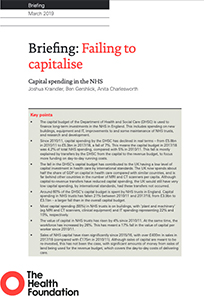Capital plan
The Health Infrastructure Plan, or HIP, unveiled at the beginning of October, promises to build 40 new hospitals over the next decade at a cost of some £13bn. But while it came amid numerous other public sector spending announcements from the government, the HIP claims to be about much more than money.
 The announcement was certainly eye-catching. Six trusts – including Barts Health
The announcement was certainly eye-catching. Six trusts – including Barts Health
NHS Trust and Leeds Teaching Hospitals NHS Trust – have been given an immediate go-ahead and will collectively receive £2.7bn to develop new hospitals over the next five years as the first phase of the plan.
This will be followed by phase two – covering 2025 to 2030 – when a further 21 schemes involving 34 hospitals will be built.
Although the Treasury has apparently committed to supporting the whole programme, the funding for phase one is seen as more secure – although the capital departmental expenditure limit (CDEL) for 2020/21, published in September’s spending round, has not yet been revised (at least not publicly). Chris Hopson, chief executive of NHS Providers, described the funding for the second phase as ‘less definitive’ and said the service needed to see the impact of the promises on capital allocations in a ‘Treasury red book-type document’.
The money is important (see box). But the HIP promises much wider benefits, with capital investment planned over the long-term, not issued in a stop-start fashion.
‘The point is to turn the capital expenditure of the NHS into a strategic, organised plan and system,’ health and social care secretary Matt Hancock told the Commons Health and Social Care Committee’s inquiry on NHS capital in October.
He added that it was part of taking a holistic approach to capital investment and the NHS needed to move away from living ‘hand-to-mouth and year-to-year’. The HIP was a new approach where ‘everything is upfront and on balance sheet’. ‘It is an attempt to turn it into a system of strategic planning rather than piecemeal decision making,’ he said.
Mr Hancock acknowledged that the old system had not met the needs of all providers and this was, in part, down to the different controls on capital spending that applied to different types of organisation.
‘Half of the system – foundation trusts in good shape – are able to spend my national budget without my say-so,’ he said. ‘So, we have to balance the capital budget by altering the decisions over individual projects of non-foundation trusts and foundation trusts that aren’t in good financial shape that we do have the power over.’
The current ‘balancing process’ can lead to late decisions on central capital investments, once the Department is confident that there is headroom within the overall spending limit – which does not fit with a planned approach to capital investment.
 ‘We need a proper planning envelope that then cascades to each local area so that each integrated care system will live within its capital budget in the same way as trusts now have indicative budgets for how much they need to live within on the resources side,’ he said.
‘We need a proper planning envelope that then cascades to each local area so that each integrated care system will live within its capital budget in the same way as trusts now have indicative budgets for how much they need to live within on the resources side,’ he said.
The HIP talks about splitting allocations into three types:
- Allocations for providers for operational investment, which would be ‘system-driven’ and self-financed
- A further pot for national strategic projects covering major schemes that require national investment and prioritisation
- A third budget for other capital investment such as technology programmes and screening system updates.
It further talks about providing ‘indicative multi-year planning envelopes over a rolling five-year period’ with these envelopes confirmed annually. This may not be capital spending limits for individual providers – NHS England and NHS Improvement have proposed a reserve power to set such limits for single named foundation trusts as part of possible legislative changes. But it sounds very much like system-level capital spending controls.
NHS England and NHS Improvement chief executive Simon Stevens admitted to the committee that the business planning and approval process had ‘almost been an implicit capital rationing mechanism across the NHS’.
‘And so in a period now where capital investment is increasing and set to increase further, frankly we need to take a lot of that delay out of the system,’ he said.
This will see the business case process streamlined, changes to contract documentation and a single approvals process rather than separate processes involving NHS England, NHS Improvement and the Department.
An expert estates team will also provide support for systems in developing capital plans. However, Mr Stevens said the service’s ability to undertake this streamlining would be ‘greatly enhanced if we have a multi-year capital budget for the health sector as a whole’.
The government has previously indicated that it will consider a multi-year capital settlement for the NHS in its next full spending review, which was bumped into next year after the Treasury’s decision to run a one-year spending round this year. The case for additional funds above those already announced, and increased certainty about future levels of funding going forward, were further strengthened in October by two publications.
First, NHS Digital published its latest Estates return information collection covering 2018/19, which showed that the total cost of eradicating backlog maintenance had risen to £6.5bn – with more than half of this classed as high or significant risk. The headline figure has increased from £5.9bn in just a year and the report also showed that just £434m was spent last year on reducing this backlog.
Meanwhile, the Health Foundation claimed that the UK was falling behind most similar countries in terms of what it spent on healthcare capital. Its analysis showed that the value of capital per healthcare worker in the UK had fallen by 35% between 2000 and 2017, while many other countries have seen significant and sustained rises.
The figures reinforce the thinktank’s earlier data showing that the UK also lags behind on healthcare capital investment as a share of GDP (see box).
The promise of a more streamlined system will be welcomed by NHS providers. Certainty over future capital budgets will also support more long-term planning, vital to the transformation of services. However, the new system will only operate effectively if there is sufficient funding in the overall capital budget.
And as many commentators have pointed out, the capital increases announced over the summer are only a downpayment on the level of funding that is actually needed.Capital demand and funding
The UK spends less on healthcare capital – including buildings, equipment and IT – as a share of GDP than most other similar countries, according to a report by the Health Foundation.
 Large growth in capital spending between 2004 and 2009 brought the UK up to the average of comparable countries at just over 0.5% of GDP, according to the report, Failing to capitalise, published in March. However, by 2016 this had fallen to 0.27%. Capital-to-revenue transfers only explain some of this reduction in spending and the UK would need to almost double its capital spending as a share of total health spending to move back to the average for OECD countries.
Large growth in capital spending between 2004 and 2009 brought the UK up to the average of comparable countries at just over 0.5% of GDP, according to the report, Failing to capitalise, published in March. However, by 2016 this had fallen to 0.27%. Capital-to-revenue transfers only explain some of this reduction in spending and the UK would need to almost double its capital spending as a share of total health spending to move back to the average for OECD countries.
New analysis from the thinktank, released in October, underlined this disparity, showing that the value of capital per healthcare worker in the UK has fallen by 35% between 2000 and 2017, while many other countries have seen significant and sustained rises. Of the countries analysed, the value of capital per healthcare worker in the UK is the second lowest, above Greece, and only just over half the average value. The UK is also investing less in equipment and machinery as a share of its total capital. It now has the lowest number of CT and MRI scanners per capita among comparable countries – and less than a third of those in Germany, which may partly explain why the UK lags behind other countries on cancer survival.
The need for increased capital can be seen in the rise in backlog maintenance. This stood at around £4.4bn in 2013/14, but the latest estates return from NHS Digital now puts this at £6.5bn.
NHS England chief executive Simon Stevens told the health and social care committee that about a third of the critical backlog maintenance related to just one London trust and that the planned major upgrade of facilities would deal with this in ‘one fell swoop’. However, he accepted that remedial investment was needed in the meantime.
Various commentators have come up with estimates for how much the NHS needs to spend on capital. According to NHS Providers, ‘we should be aiming to at least double the NHS current capital spend and sustain that growth’. The IPPR effectively agrees, with a report in September calling for a £5.6bn boost to CDEL next year to bring the service in line with the OECD average capital spend per person.Related content
The Institute’s annual costing conference provides the NHS with the latest developments and guidance in NHS costing.
The value masterclass shares examples of organisations and systems that have pursued a value-driven approach and the results they have achieved.